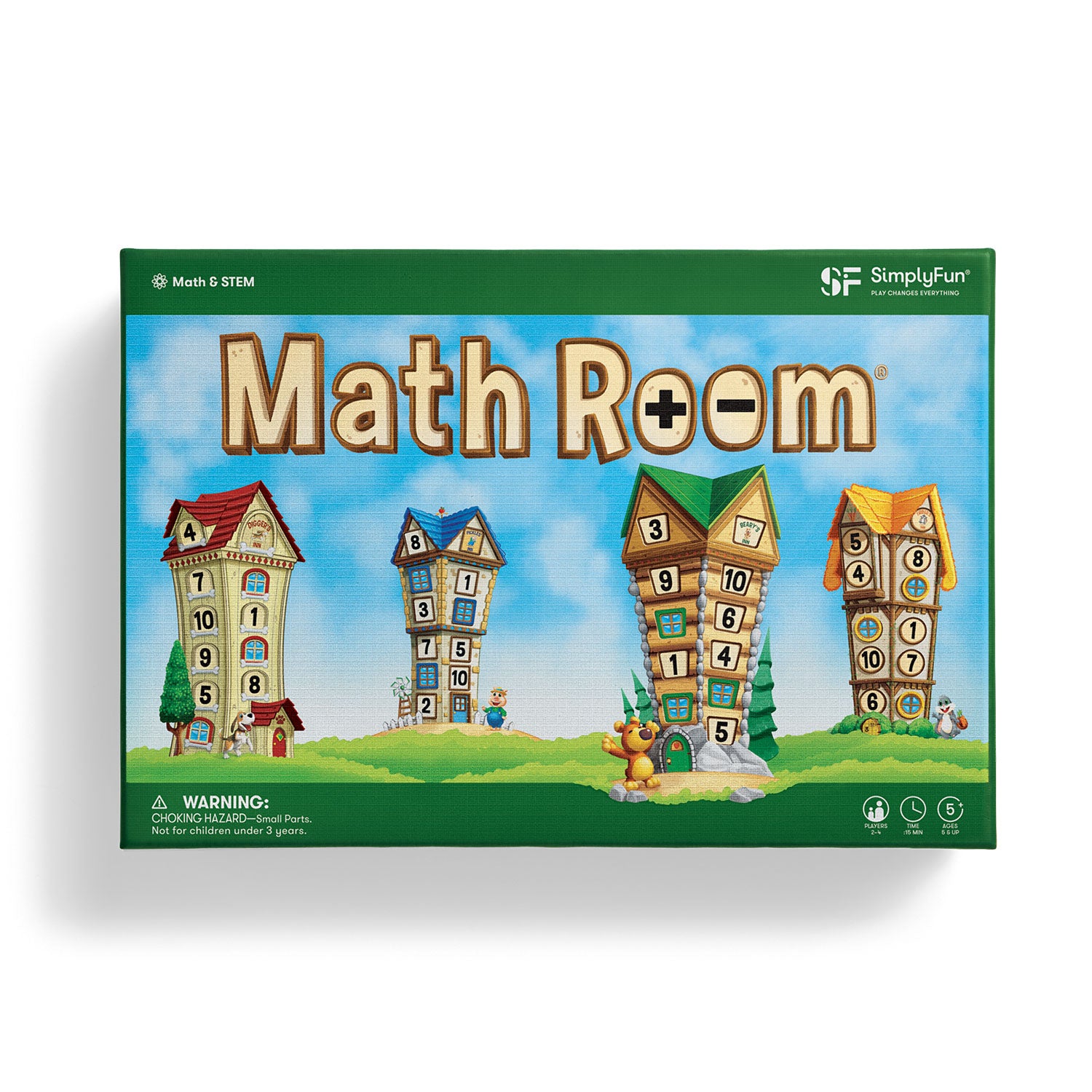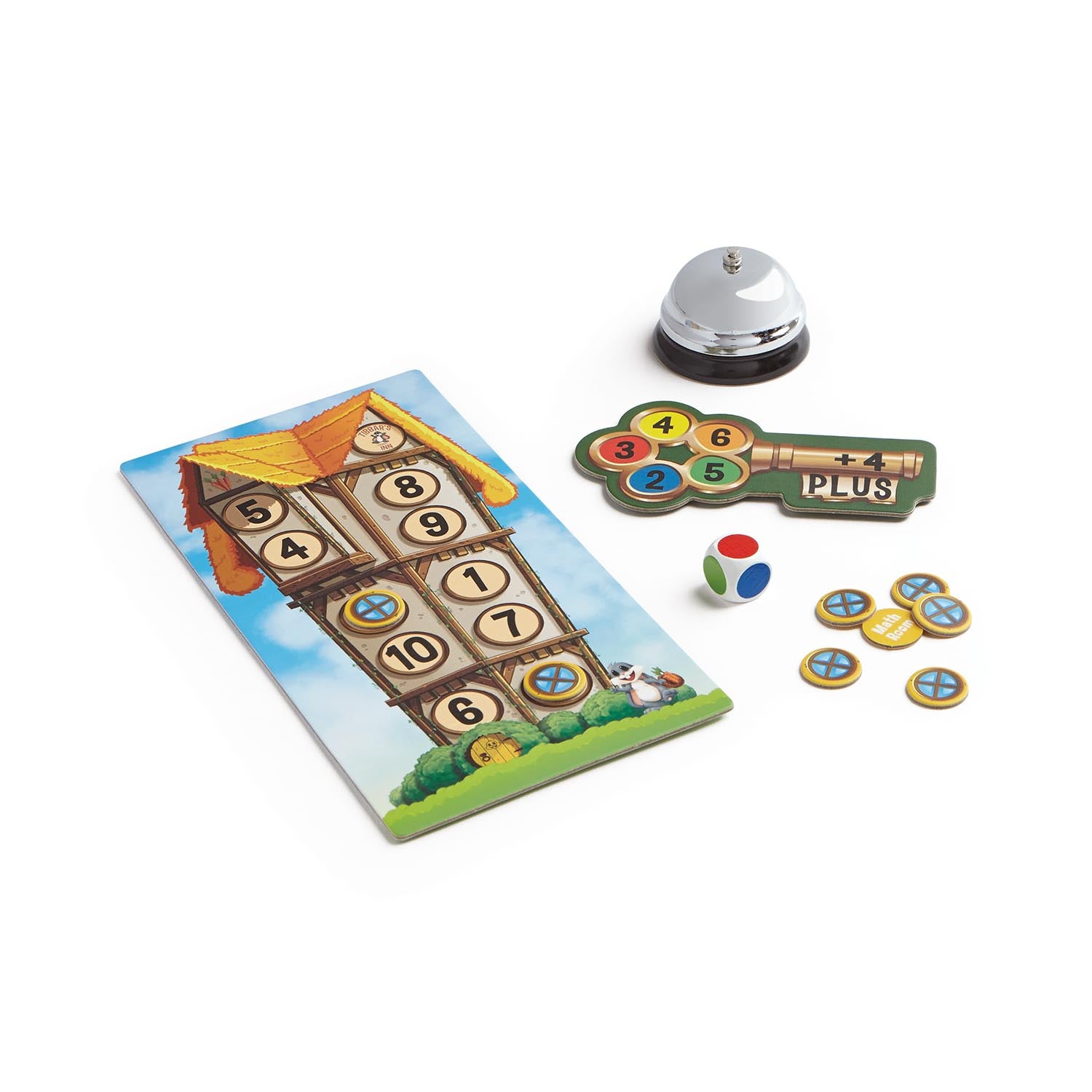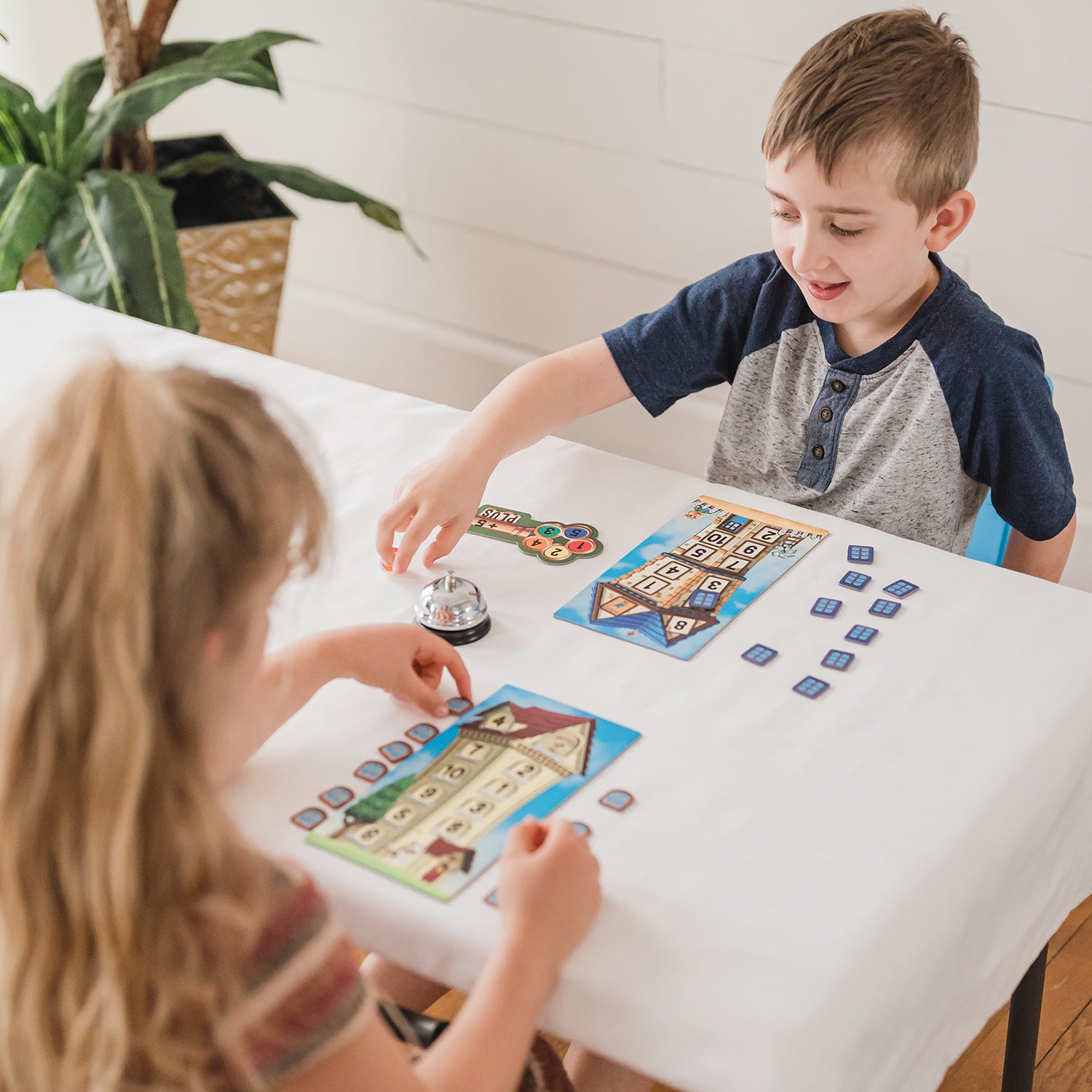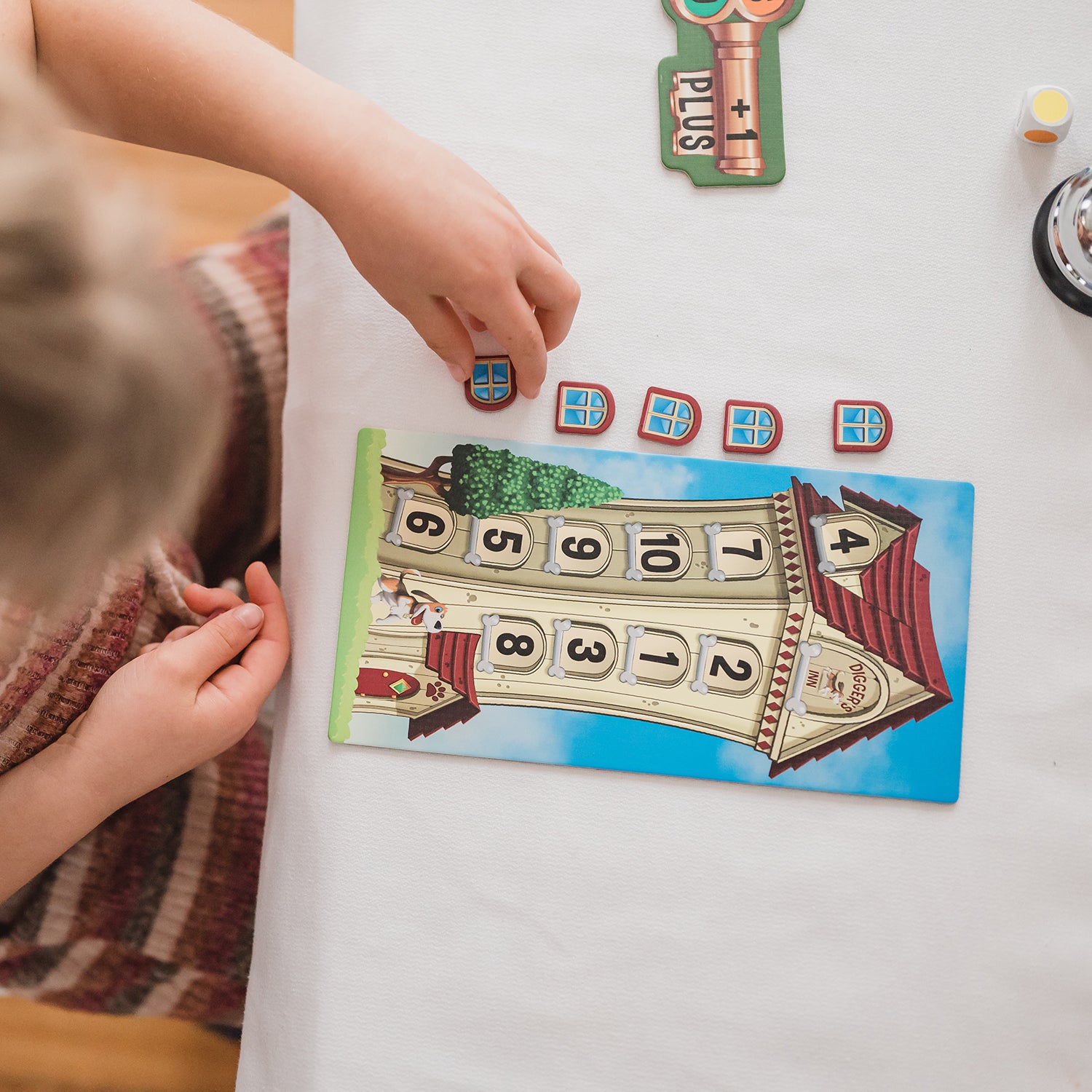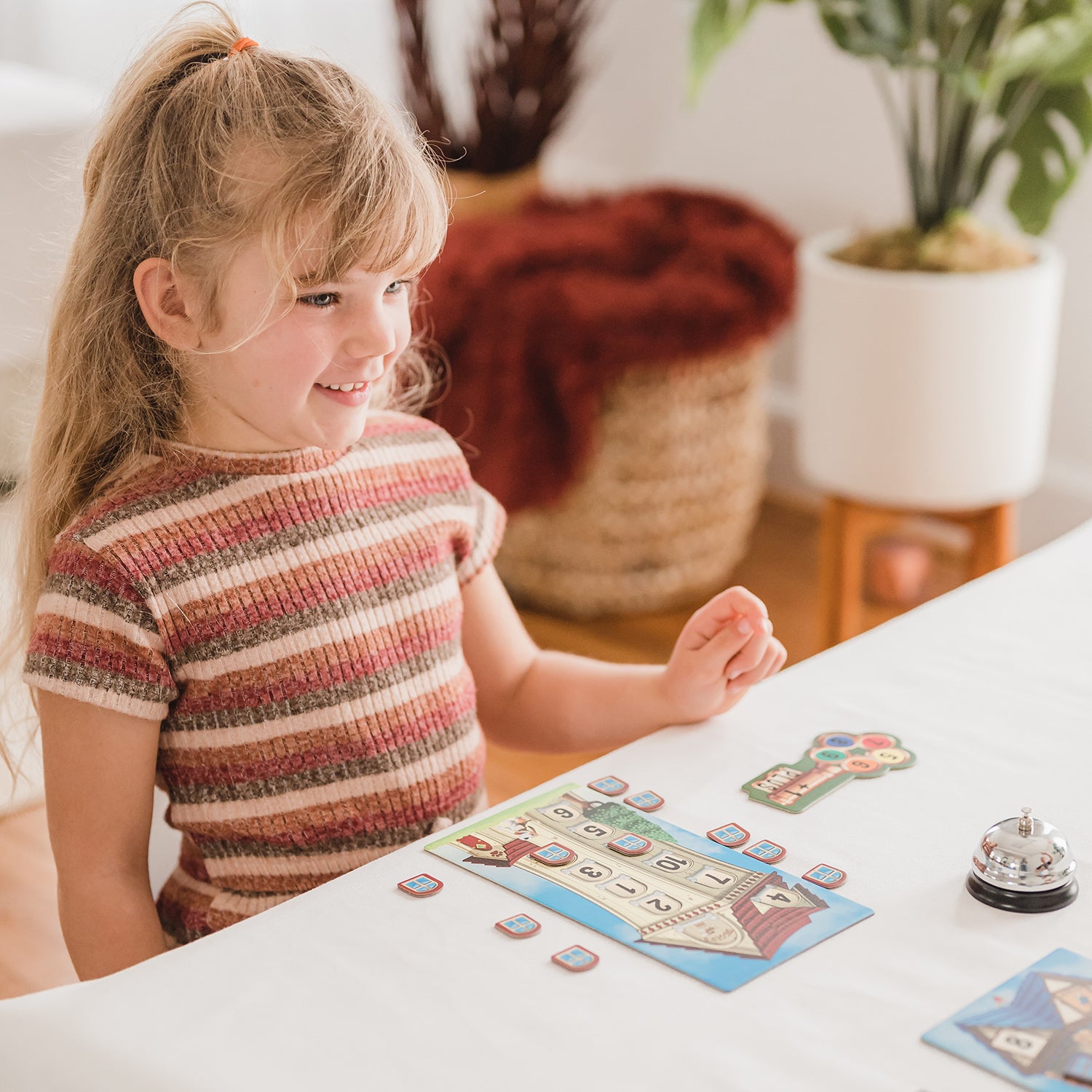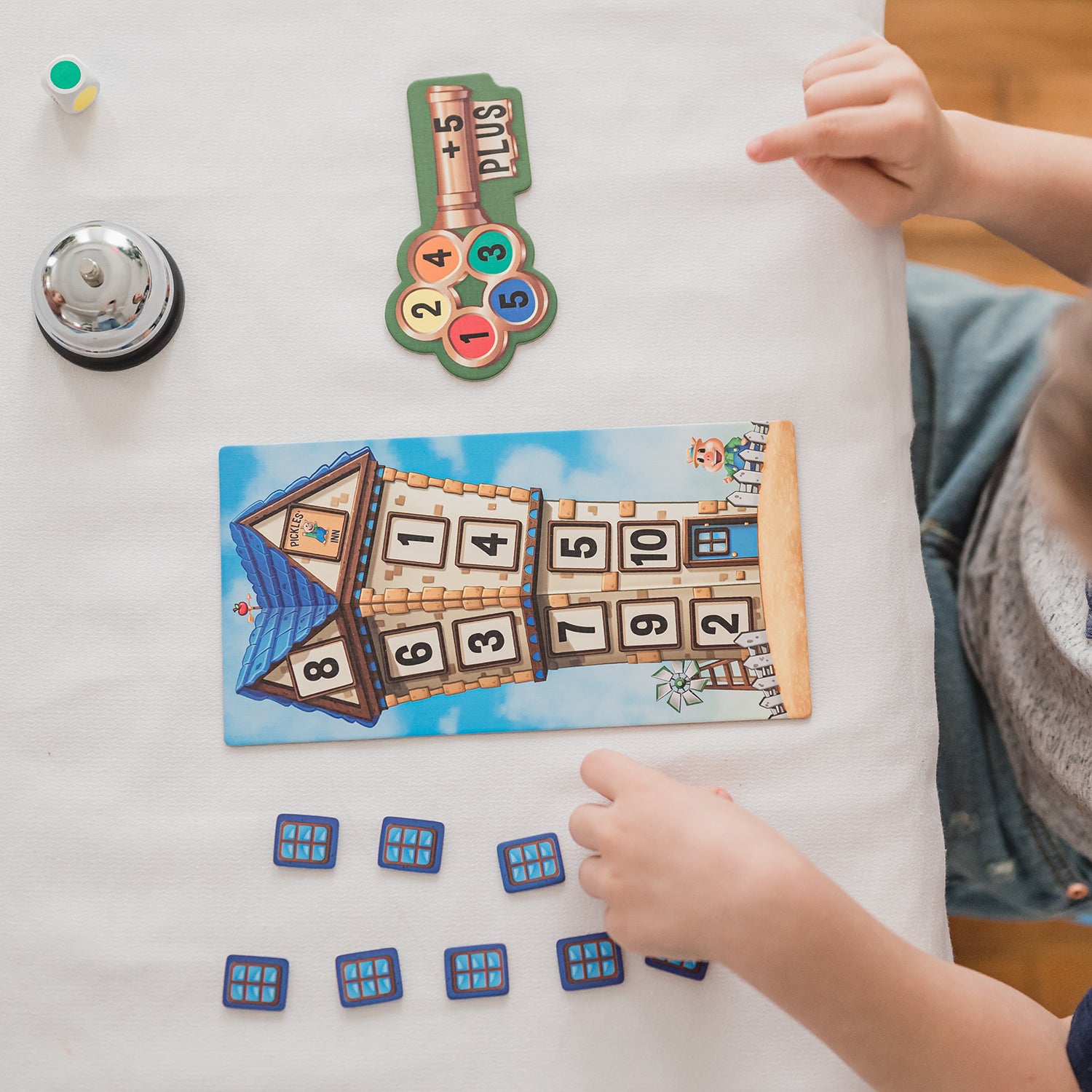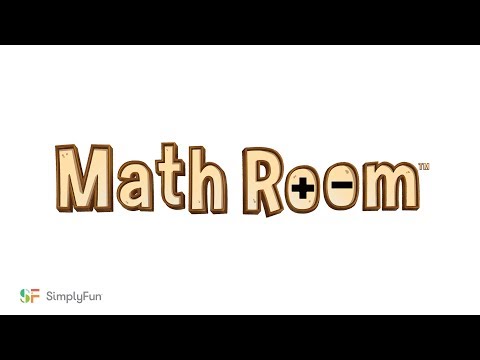Math Room
Math Room
2-4 players • 15-20 min • 5 & up
Focus: Addition
Couldn't load pickup availability
A good innkeeper knows numbers. A great innkeeper knows how to use them. Think fast and solve the addition and subtraction problems on your key to close the windows before someone puts you out of business.
Skills: Addition, Subtraction, Quick Thinking
Game Includes
Game Includes
- 4 Math Room Boards
- 4 key Boards
- 40 Window Tokens (4 sets of 10)
- 1 Wood Die
- 1 Metal Bell
- 1 Rules Booklet
Share
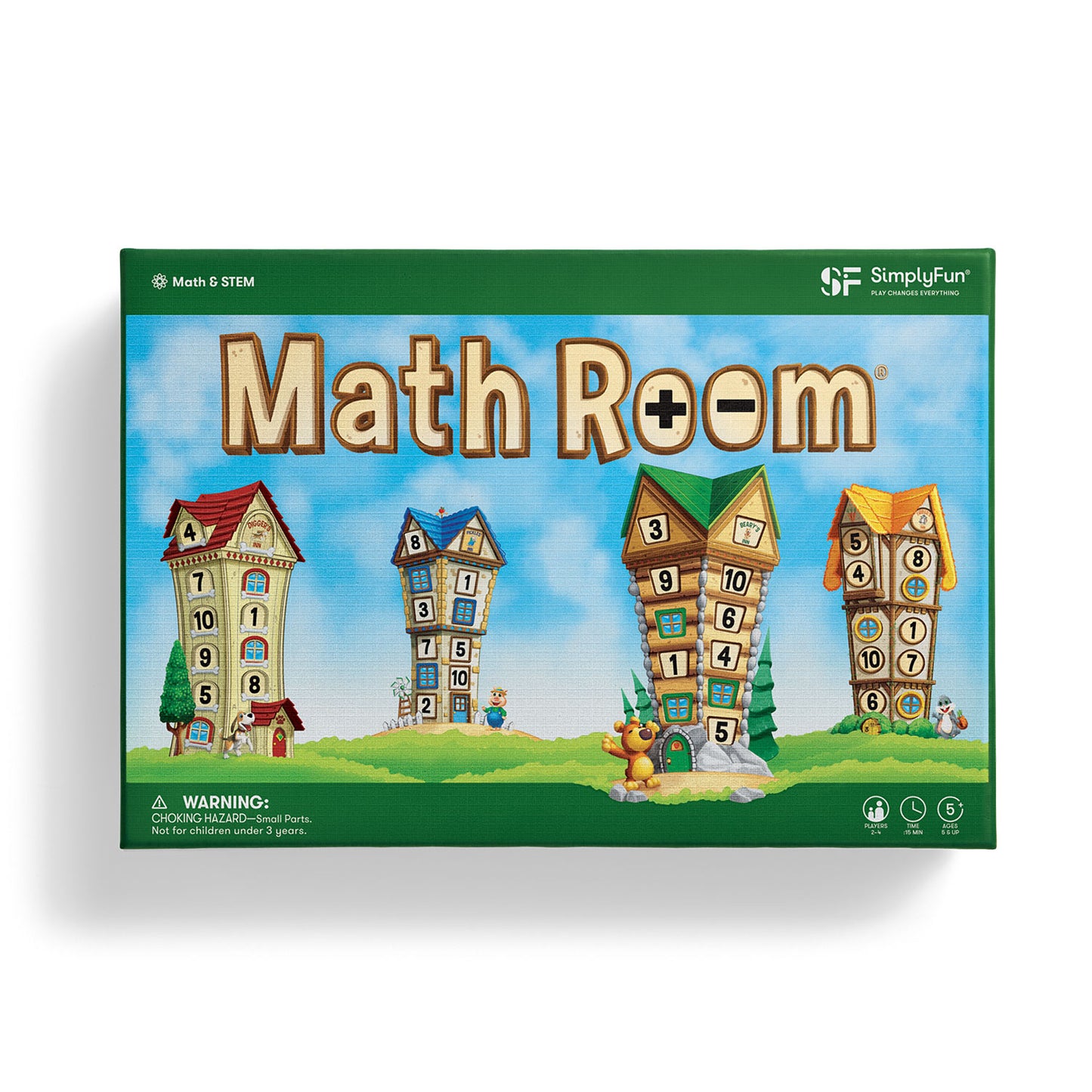
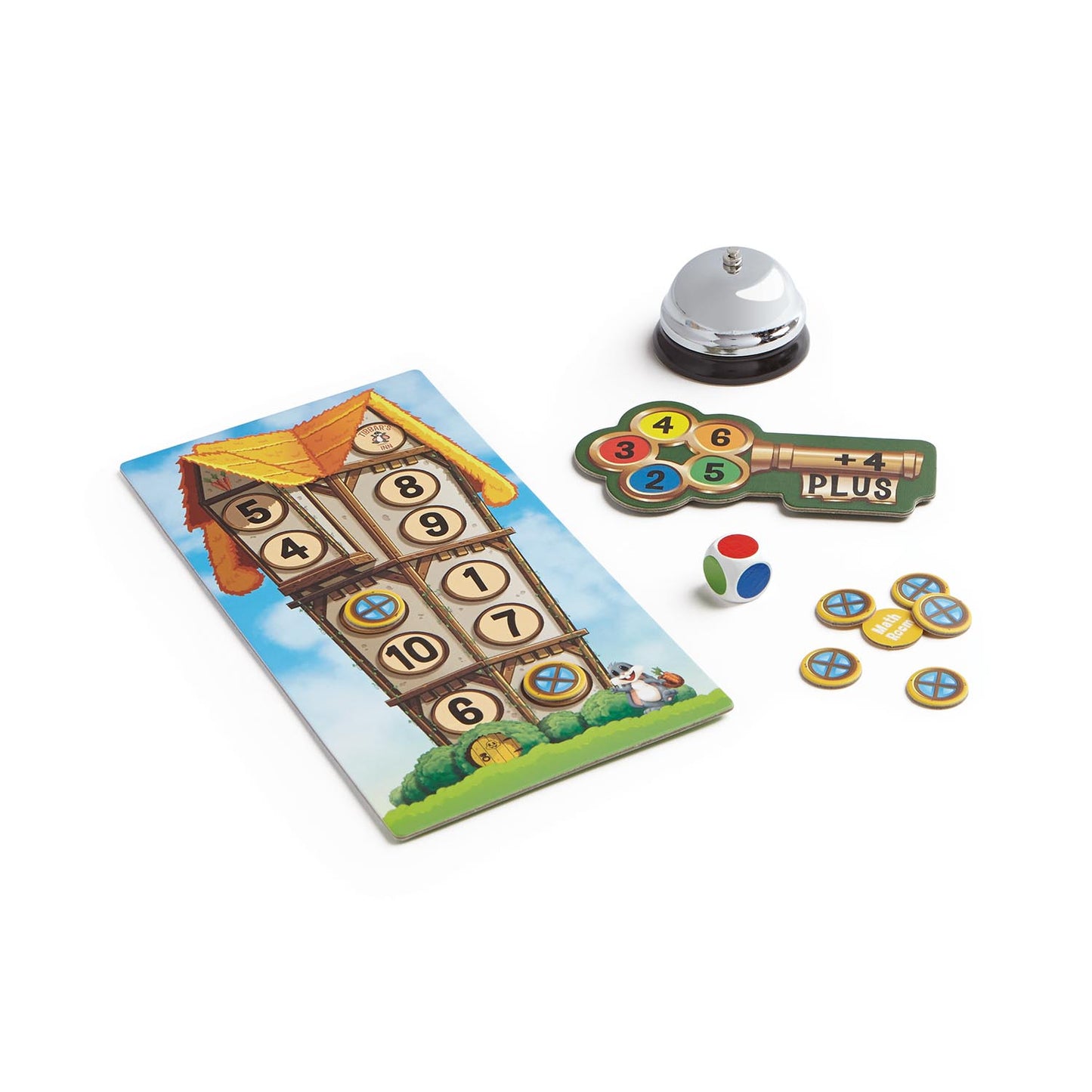
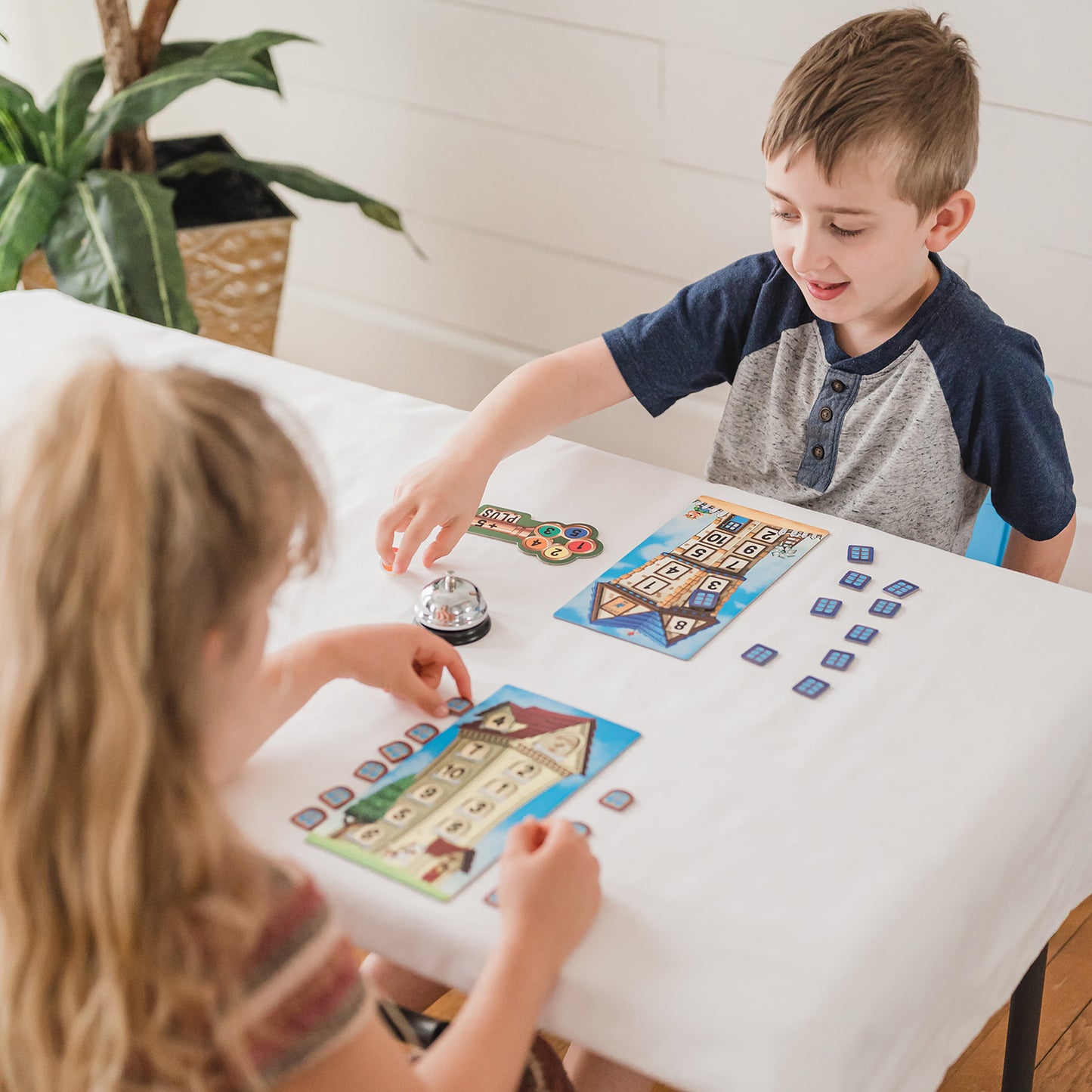
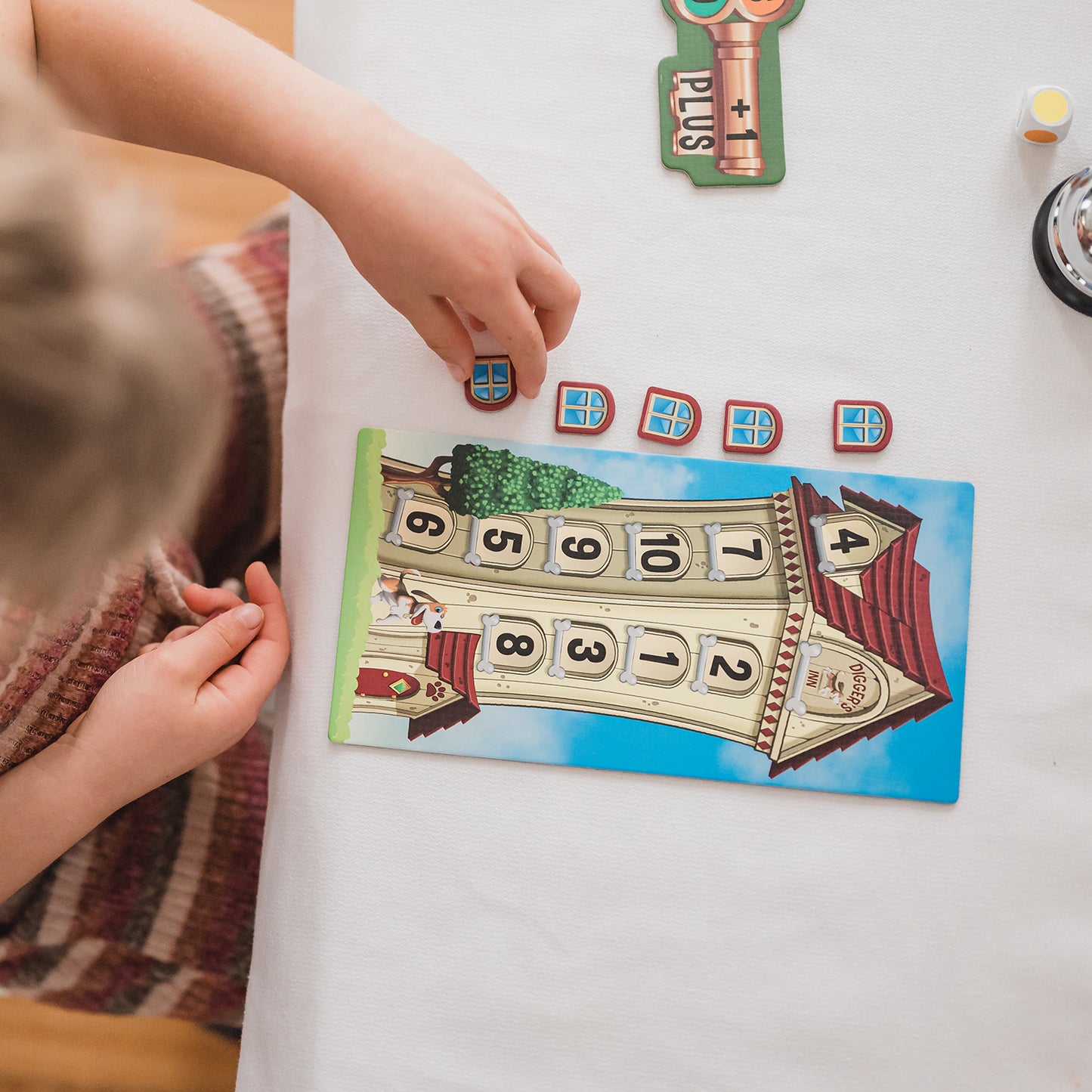
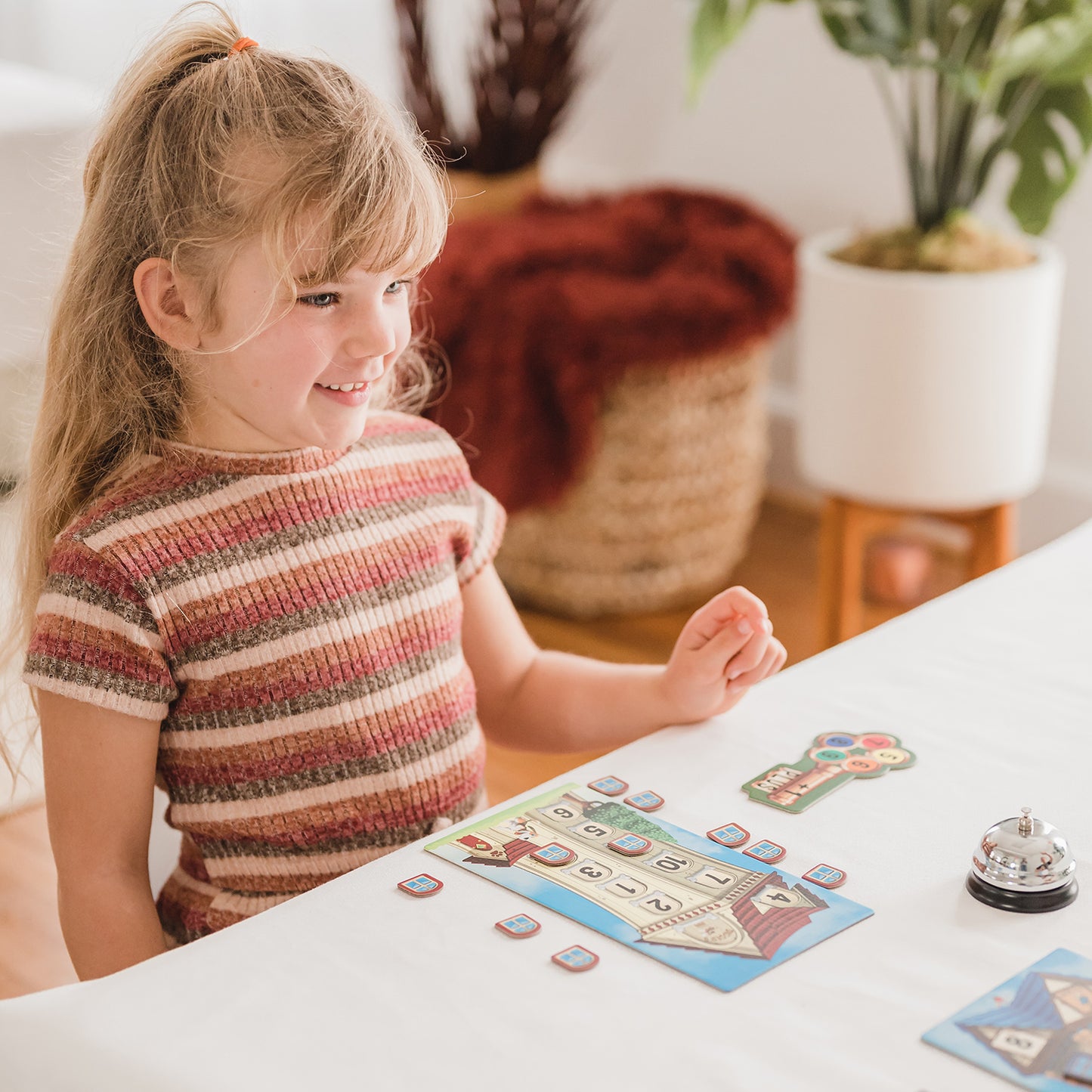
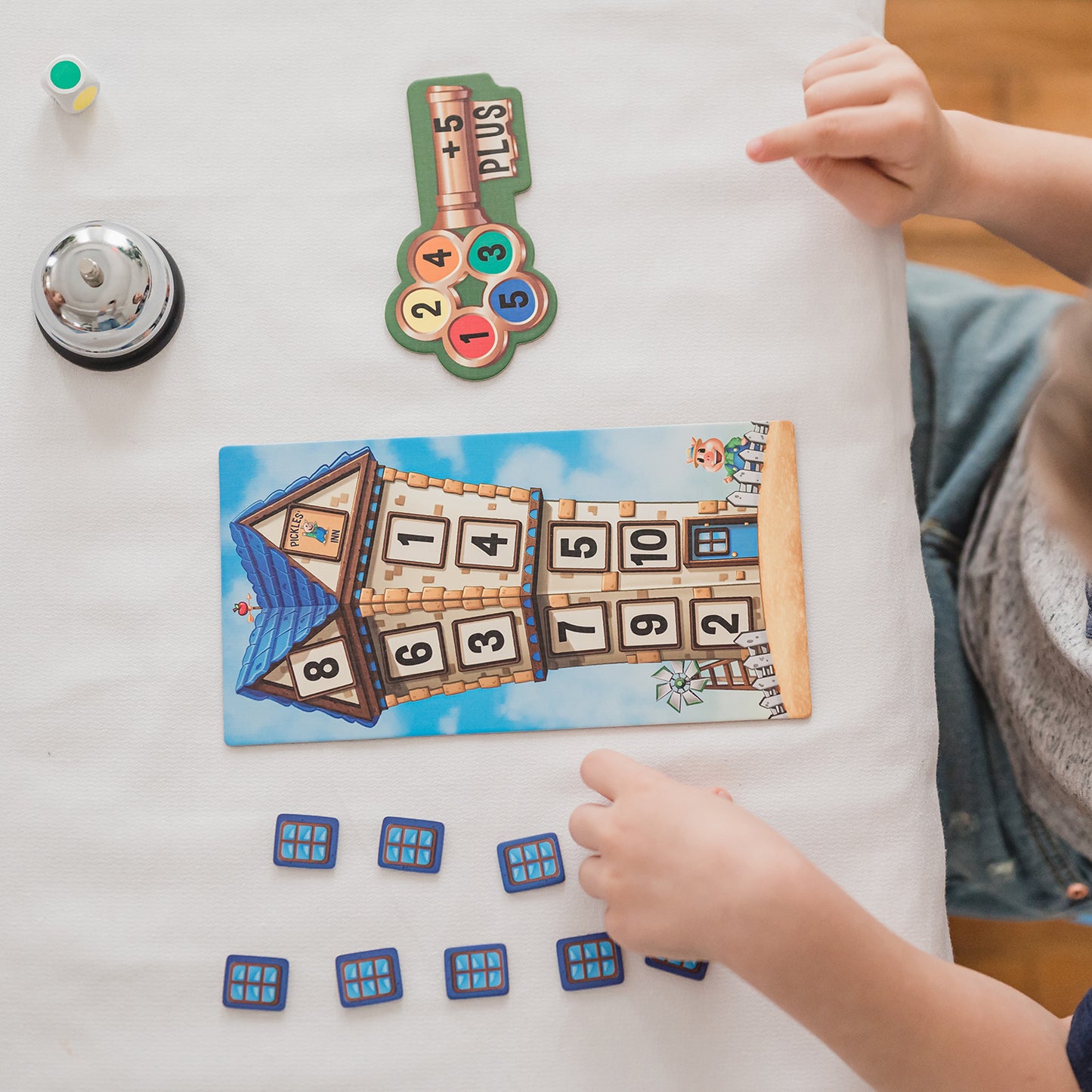


Collapsible content
How to Play
Educational Standards
Core Standard*: Math
Math
- Counting and Cardinality
- Know number names and the count sequence. Grade Levels K
- Operations and Algebraic Thinking
- Understand addition as putting together and adding to, and understand subtraction as taking apart and taking from. Grade Levels K
- Represent and solve problems involving addition and subtraction. Grade Levels 1st
Skills
Determine
What Does Child Do To Use Skill In The Game?
Players determine where to put a window, if possible. They also need to quickly determine if they will ring the bell.
How Parents Can Assist Learning
Parents can monitor children's solutions to ensure that an accurate result was reached. For example, if the equation was 7 + 3, did the child place a window on number 10?
Learning Implications and Educator Support
Math Room gives children option to use addition or subtraction on each turn. Educators can remind children to look at both sides of their Key Card, but they need to do it quickly. If someone else rings the bell first, then no other players can use the opposite side of the Key Cards. Additionally, educators can monitor children's solutions to ensure that an accurate result was reached. For example, if the equation was 7 + 3, did the child place a window on number 10?
Compare
What Does Child Do To Use Skill In The Game?
Players compare color on die with those on Key Board.
How Parents Can Assist Learning
There is no special adult support required.
Learning Implications and Educator Support
There is no special adult support required.
Remember
What Does Child Do To Use Skill In The Game?
Players need to remember the addition and subtraction functions and processes.
How Parents Can Assist Learning
Parents can remind children how adding or subtracting works, if they get stuck. Also, suggest that they use fingers or manipulatives (ex: 10 raisins) to assist them in adding or subtracting.
Learning Implications and Educator Support
Educators can remind children how adding or subtracting works, if they get stuck. Also, suggest that they use fingers or manipulatives (ex: 10 raisins) to assist them in adding or subtracting.
Practice
What Does Child Do To Use Skill In The Game?
Playing this game allows players to practice and master adding and subtracting between 1-10.
How Parents Can Assist Learning
Allowing younger children to use manipulatives, such as raisins, can help aid in the learning process. For example, if a child has the "4 Plus" side of a Key Board up, lay out 4 raisins in a row, create a space, and then lay out another 6 raisins in a row. If "blue" is rolled, the child can move 2 raisins next to the 4 raisins, and then count them up to determine the result.
Learning Implications and Educator Support
Allowing younger children to use manipulatives, such as raisins, can help aid in the learning process. For example, if a child has the "4 Plus" side of a Key Board up, lay out 4 raisins in a row, create a space, and then lay out another 6 raisins in a row. If "blue" is rolled, the child can move 2 raisins next to the 4 raisins, and then count them up to determine the result.
Solve
What Does Child Do To Use Skill In The Game?
Players solve the math problems presented.
How Parents Can Assist Learning
Solving math problems is the primary goal of the Math Room, allowing children to practice and master important addition and subtraction skills. Parents can encourage children to explain why they chose subtraction or addition, as well as how they solved the problem. If children produce incorrect mathematical results, parents can work with child to examine the problem to help them learn the correct procedures.
Learning Implications and Educator Support
Solving math problems is the primary goal of the Math Room, allowing children to practice and master important addition and subtraction skills. Parents can encourage children to explain why they chose subtraction or addition, as well as how they solved the problem. If children produce incorrect mathematical results, parents can work with child to examine the problem to help them learn the correct procedures.
Review
What Does Child Do To Use Skill In The Game?
Children may review if encouraged. See How Parents Can Assist Learning.
How Parents Can Assist Learning
For children that are having difficulty solving the problems, review the principle of addition or subtraction with them. Ask children to explain their thinking, especially when they are incorrect. This can help parents understand the child's thinking and help the child to identify how to do it correctly next time.
Learning Implications and Educator Support
For children that are having difficulty solving the problems, review the principle of addition or subtraction with them. Ask children to explain their thinking, especially when they are incorrect. This can help educators understand the child's thinking and help the child to identify how to do it correctly next time.
Demonstrate
What Does Child Do To Use Skill In The Game?
Children may demonstrate if encouraged. See How Parents Can Assist Learning.
How Parents Can Assist Learning
Encourage children to explain how they solved a problem. Use manipulatives, such as raisins or blocks, if needed. Using manipulatives provides kinesthetic and visual support to learning the abstract concepts of numeracy, addition and subtraction.
Learning Implications and Educator Support
Encourage children to explain how they solved a problem. Use manipulatives, such as raisins or blocks, if needed. Using manipulatives provides kinesthetic and visual support to learning the abstract concepts of numeracy, addition and subtraction.
*Data compiled from CCSSI ELA Standards, WA Science Standards, and Washington Social Studies Standards
Special Needs
Cognitive
Suggestions for How to Modify Play Experience
Use either the addition or subtraction keys, not both. When using the addition key, cover numbers 1-5 on the math room board card at the start of the game. When using the subtraction key, cover numbers 6-10. This allows children to concentrate on one operation, rather than having to switch from one to another. Eliminate the key switch aspect of the game and just keep rolling until another color comes up.
Give each child 10 small blocks. Let children use the blocks to determine the total after they add or subtract what was on the game cards. The manipulative help children solve the problem with concrete objects prior to doing mental math.
Work in pairs to solve problems. Have children count aloud and talk about what they are thinking before giving an answer. This will help the child with cognitive delays follow the process. If children are using manipulatives have them demonstrate their thinking.
Communication
Suggestions for How to Modify Play Experience
Walk children through examples of playing the game before starting. This will make the directions easier to understand.
Ask children to explain how they got their answers. This requires them to use language to explain their sequence of thought. If they are wrong, this will help the adult know where the child made a mistake.
Sensorimotor
Suggestions for How to Modify Play Experience
If children get the window tabs in close proximity to the window that is sufficient. The adult can then help position the window.
Social Emotional/Behavioral
Suggestions for How to Modify Play Experience
Collaborative problem-solving can help children learn to work together. Particularly for children who need to work with manipulatives, cooperation can support learning and social skill development.
Some children may become obsessed with banging the bell just to hear it ring. For hyperactive or impulsive children, take turns being able to hit the bell. Move the bell from one player to another around the game table. This way children who are slower to move have a chance, and the impulsive child has to wait for a turn at the bell.
Have children count aloud and talk about what they are thinking before giving an answer. This will help the child with impulsive behaviors follow the process.
Vision
Suggestions for How to Modify Play Experience
For each Key create a large template of matching colors and numbers to use instead using the included game Key. For example, for the with key 4+ on one side and 8- on the other, take a sheet of paper and on one side write a large 4+ . Then draw five large circles. Color them and add the corresponding numbers. Flip the sheet of paper and repeat for 8-. This will enable children with low vision to see the numbers.
Some children may be able to see better if items are positioned in their line of sight (not necessarily in the middle). Move the materials until the child indicates the materials are aligned maximally for sight. Use a slanted board or other stand that positions the materials at a better angle and height for the child to see.
Hearing
Suggestions for How to Modify Play Experience
Children with hearing impairments should be able to play this game.
*Data compiled from CCSSI ELA Standards, WA Science Standards, and Washington Social Studies Standards
Autism
Autism Strengths & Interests
Short Summary of Strengths & Interests
- Likes simple addition and subtraction.
- Enjoys simple puzzles.
- Likes to make numerical matches.
Is good at matching visual items
This game is not appropriate
Has a good memory for sensory details, including visual, touch, taste and smell
This game is not appropriate
Has a good memory for words, phrases and dialouge
This game is not appropriate
Has a good memory for pictures, numbers and patterns
Is This Game Appropriate? Yes
Description
Children who know simple addition and subtraction will enjoy showing off those skills in Math Room. On each turn, the players need to perform a single digit math problem as quickly as possible. If needed, play the game in turns rather than everyone playing simultaneously in order to allow a child with autism enough time to find the needed sum for their game board.
Likes to put things in order or a sequence
Is This Game Appropriate? Yes
Description
For children with autism who are good at organizing and sequencing, Math Room is a good game. During the game, players will place window tiles on the correct spot on their game board. Additionally, each turn involves a simple addition or subtraction sequence.
Learns through visualizing or "replaying" actions in their mind
This game is not appropriate
Likes activities with rules, such as math and phonics
Is This Game Appropriate? Yes
Description
Some children with autism enjoy activities that have clear rules for guiding their experience. Because Math Room is based on simple addition and subtraction, it is good for children like this who like math.
Is very concrete and literal
This game is not appropriate
Learns in small "chunks" (for example, phone numbers are 3 chunks of number xxx-xxx-xxxx that are combined together)
This game is not appropriate
Is good at nonverbal reasoning and logic
This game is not appropriate
Likes spatial problem solving
This game is not appropriate
Can read well with good vocabulary, though may not fully comprehend content
This game is not appropriate
Likes to use and has good fine motor skill
This game is not appropriate
Likes established routines or set ways of doing things
Is This Game Appropriate? Yes
Description
Some children with autism strongly prefer the same routine. These children will enjoy Math Room since every round of the game is the same, and the math itself is simple and follows clear rules.
Likes manipulating, constructing or building things
Is This Game Appropriate? Yes
Description
The winning player in Math Room is the person who covers all the spaces on their game board with 10 window tiles. Children who are good at and enjoy activities like Bingo, sorting and playing with blocks will use similar skills in Math Room. Additionally, it can be very motivating for these children to keep playing the game in order to fill in any missing spots.
Likes to use and has good musical abilities
This game is not appropriate
Likes to use and has good drawing skills
This game is not appropriate
Autism Special Considerations
Appears to ignore other's communication and/or has difficulty giving eye contact to a communication partner
Is This Game Appropriate for Child with Characteristic? Yes
Can Child with Characteristic Play Game w/o Modification? Yes
Strategies for Developing Compensatory Skills:
Look at the game instead of each other.
Communication is not needed in Math Room, but should be encouraged.
Has difficulty understanding complex verbal directions
Is This Game Appropriate for Child with Characteristic? Yes
Can Child with Characteristic Play Game w/o Modification? No
Strategies for Developing Compensatory Skills:
Break down directions into small steps. Don't go through all the directions at once.
Combine short verbal instructions with visual and physical examples of each step.
Use hand-over hand guidance if needed, so children feel the actions as the directions are being given. This helps develop the child's memory for the correct movements. Gradually reduce the support as the game is learned.
Check for comprehension by asking the child to show you what to do next. For example, if a number on the board is already covered up, ask the child, "Is there something you can do with the key to try another way?"
Let children read the directions as they are explained. Visualizing the words is often a stronger learning method for children with autism.
Uses vocabulary inaccurately or demonstrates echolalia (repeating another's speech)
Is This Game Appropriate for Child with Characteristic? Yes
Can Child with Characteristic Play Game w/o Modification? Yes
Strategies for Developing Compensatory Skills:
Respond to immediate echolalia (repeating what was just said) by rephrasing the child's response into a correct format, so the child can hear and repeat that phrase. For example, assume you are playing with a child named Andy and you say, "Your turn," and Andy repeats, "Your turn." You can say, "It's Andy's turn. You say, my turn." This allows the child to hear and repeat the correct response. Eventually, the child will pick up the pattern of response.
Delayed echolalia (repetition of previously heard comments) may have a hidden meaning or association. Look for connection in the phrase used to the current situation. For example, the child says, "After these messages we'll be right back!" Think what the repeated phrase is associated with for the child. Try to interpret what is meant and rephrase it for the child. For example, you might respond by saying, "It sounds like you want a break for a few minutes. Is that what you mean? You can tell me, 'I need a break.'"
Gets stuck repeating a verbal topic or physical actions and/or has difficulty attending to others' actions or topic.
Is This Game Appropriate for Child with Characteristic? Yes
Can Child with Characteristic Play Game w/o Modification? Yes
Strategies for Developing Compensatory Skills:
Remind children about listening and watching others' before making their own comment or action.
Use a motivation toy or object to gain the child's attention. For example, a preferred wind-up toy can be placed on the board when it is the child's turn. The child gets to wind up the toy after completing their turn.
Extend the child's action to make a correct response. For example, if the child doesn't think to turn the key over, the adult can turn the key over, then turn it back. The child may then be reminded of this option.
Reinforce attention and actions by commenting on what was done correctly. For example, "You remembered option on the other side. Good for you!"
Has difficulty producing speech/communication
Is This Game Appropriate for Child with Characteristic? Yes
Can Child with Characteristic Play Game w/o Modification? Yes
Strategies for Developing Compensatory Skills:
Use gestures and sign language to illustrate actions or concepts. For example, use the sign for 'finished' (turn two hands to face down, then spread outward from the center of the body), point to the next player and say, "I'm done. It's your turn." The signs and gestures add a visual component to support understanding.
Talking is not required, but ask players to say their math problem out loud. This gives the child practice in initiating a conversation. The adult should respond with a conversational turn. For example, the child says 6-3=3 and covers the three. The adult can say, "I had six cookies and you ate 3. 3 are left." This gives the child an example of the meaning of the problem and also offers a response to his statement.
Provide at least 10 seconds wait time for the child to process or produce responses. It may take longer to formulate a thought or response for children with special needs.
Has difficulty sequencing multi-step actions and/or doing complex abstract tasks
Is This Game Appropriate for Child with Characteristic? Yes
Can Child with Characteristic Play Game w/o Modification? No
Strategies for Developing Compensatory Skills:
Provide manipulatives, such as blocks to make the problems more concrete.
Remembering the option of turning over the key, may be difficult for some children. One option is to take a picture of the opposite side of the key and leave it next to the actual key so the child can see both sides at once.
Demonstrates difficulty initiating and maintaining social interactions
Is This Game Appropriate for Child with Characteristic? Yes
Can Child with Characteristic Play Game w/o Modification? Yes
Strategies for Developing Compensatory Skills:
Develop a social story to be read at the start of a game. A social story is a short booklet that illustrates how a child can use positive social skills. It includes two to five descriptive statements and a directive statement. For example: "When I watch others, I will know when it is my turn. Others like me when I take turns. I will watch what others do with their pieces and listen to what they say. Others like it when I talk about the game." Add photos or drawings of the child doing the actions described in the story.
Add a social component to the game by having children make up silly story problems to illustrate the problems. For example, "Six monsters ate 5 goats. Only one goat was left."
Acts out or demonstrates avoidance behaviors when frustrated, overwhelmed, or needs more sensory input.
Is This Game Appropriate for Child with Characteristic? Yes
Can Child with Characteristic Play Game w/o Modification? No
Strategies for Developing Compensatory Skills:
Reduce extraneous noise or allow the child to wear head phones or ear plugs if loud sounds cause anxiety.
A weighted vest worn during the game may provide additional pressure input and thus reduce fidgeting due to sensory needs. Pressure can be calming when used for no more than 20 minutes at a time.
Practice a phrase to ask for help and role play situations in the game where it is needed.
Provide techniques for self-calming, such as holding a special toy.
Allow time for movement. For example, a child who needs to move frequently can be given an opportunity to 'celebrate' their turn by running around the table or jumping up and down 10 times.
Has short attention span for non-preferred activities
Is This Game Appropriate for Child with Characteristic? Yes
Can Child with Characteristic Play Game w/o Modification? No
Strategies for Developing Compensatory Skills:
Provide a break when needed.
Use "when...then" phrases. For example, "When you take your turn, then I'll let you play with your toy."
Frequently remind the child of the goal of the game. "You need to fill up all the spaces on your board. You only have two left."
Incorporate a motivating activity as part of the play. For example, each player gets to manipulate a fun 'fidget' toy, such as a stress ball or squeeze toy in between turns.
Needs sameness or consistent routines and/or has difficulty with transitions from one activity to another
Is This Game Appropriate for Child with Characteristic? Yes
Can Child with Characteristic Play Game w/o Modification? No
Strategies for Developing Compensatory Skills:
Has difficulty understanding others' feelings, intentions, and the reasons for others' actions.
Is This Game Appropriate for Child with Characteristic? Yes
Can Child with Characteristic Play Game w/o Modification? No
Strategies for Developing Compensatory Skills:
Play games at the same time every day, so the child anticipates the game routine.
Change the location of the game, so the child may play in different rooms, at the table, or on the floor. This will build tolerance for variation. Prepare the child ahead time for the introduction of a new game. Talk about aspects that will be motivating for the child, and let them explore the parts of the game before setting out the whole game.
Provide a structure for placement of game pieces that can be the same each time the game is played. For example, have a specific location for where the board goes, the pieces, etc.
Provide choices for how the child can be involved in set up or clean up. For example, you might ask, " Do you want to hand out the cards or set out the windows and keys ?" Involve the child verbally and with actions for the transition to the game table or at the end of game play. For example, you might say, "Let's look at the pictures on the game box and guess what it is about."
Use an object cue. Let the child hold an object from the game or activity you want to introduce prior to the transition. For example, if you were intending to play Math Room you would hand the child key and say, "Look here is a key. Let's see what it is for."
*Data compiled from CCSSI ELA Standards, WA Science Standards, and Washington Social Studies Standards
Extended Play
Extra Ways to Play the Game
Work in teams to collaborate. This allows children to hear how other children think. They can also correct each other.
Materials Needed
No addition materials needed. However, add blocks if children need manipulatives to help them solve the problems.
Developmental Benefits
Children learn from watching and listening to their peers. They can also build social skills by working together to find the solutions.
Extra Ways to Play the Game
When the key comes up on the die, each player gets up and moves one seat to the left. This gives each player a new board, adding a new element of surpise and chance into the game.
Materials Needed
No addition materials needed.
Developmental Benefits
This modification helps level the playing field for children who may not be as good in math as other players. Children know when they are not good at something, so they want to quit. By rotating boards, children may be more motivated to play. On the other hand, children who are good at math may quickly add tokens to the new board.
Extra Ways to Play the Game
Play math bingo. Give each player a Math Room card and a Key. Call out a number from 1-10. Each player must announce an equation on their Key that results in the number called. If they are correct they get to cover the number called.
Materials Needed
No addition materials needed. However, add blocks if children need manipulatives to help them solve the problems.
Developmental Benefits
This modification teaches children that there are multiple ways to add or subtract and arrive at the same result. Children will also check each others' answers and announce when they are incorrect.
*Data compiled from CCSSI ELA Standards, WA Science Standards, and Washington Social Studies Standards
Collapsible content
How to Play Video & Transcript
A game where players must think fast solving addition and subtraction problems.
You can play Math Room with 2-4 players, ages 5 and up.
Math Room is good for developing Addition and Subtraction skills as players complete and solve the equations on their boards.
Math Room also helps with Quick Thinking skills as players compete against one another to be the first to ring the bell when they need to flip their key to the other side.
What’s in the box? 4 Math Room Boards (double-sided), 4 Key Boards (double-sided), 40 Window Tokens, 1 Wood Die, and 1 Metal Bell.
To set up the game each player takes one character’s Math Room Board and 10 Window Tokens that match that board’s roof color and window frame shape. The Math Room Boards have two sides and players may choose either side to play. Players also take one Key Board of their choice. The Key Boards have addition on one side and subtraction on the other side. Players may start with either side facing up. Before starting the game, place the Metal Bell in the middle of the table so all players can reach it.
The player whose birthdate is closest to the number 5 starts by rolling the Wood Die.
Each turn consists of a player rolling the Wood Die. All players then match the color rolled to a color on their Key Board to complete math equations. The handle sections of the Key Boards contain part of an incomplete equation (“+ 1”, “+ 4”, “+ 5”, “+ 3” or “10 –”, “8 –”, “7 –”, “6 –”). Players complete the equation using the numbers on the color of their Key Boards that matches the color rolled on the die. Players then use their Math Room Boards to find the correct answer to the equation and cover up that number with a Window Token.
After all players have solved their equations and placed their Window Tokens; play continues clockwise with the next player rolling the die.
For instance, if Player A rolls orange, all players would look at their Key Board to see what number is in the orange space. Player A’s Key Board contains a 6 in the orange space and has a “+ 4” on the handle, so Player A would solve the equation by adding 6 + 4. Player A would then cover up the number 10 on their Math Room Board with a Window Token since 10 is the correct answer.
Player B’s Key Board contains a 5 in the orange space, however there is a “7 –” on the handle, so Player B would solve the equation by subtracting 7 – 5. Player B would then cover up the number 2 on their Math Room Board with a Window Token since 2 is the correct answer to that equation.
If the number on your Math Room Board is already covered by a Window Token you can try ringing the Metal Bell to solve a new equation, otherwise your turn is over and you must wait until the next die roll. After all players have solved their equations and covered up the correct answers play continues clockwise and the next player rolls the die.
Players ring the Metal Bell when they want to flip their Key Board over and use a different math operator because they cannot or do not want to solve the current equation for that turn. Only the first player to ring the bell can turn their Key Board over to solve the equation on the opposite side. If the player that flipped their Key Board over cannot solve the new equation (i.e. there is already a Window Token on that answer) then their turn is over. Only one player per turn is allowed to flip their Key Board. The other players continue to play the current side of their Key Board if they can. After placing tokens, play continues clockwise, as normal, with the next player rolling the die.
When a player rolls the key symbol on the Wood Die, that player calls out “switch to the left” or “switch to the right”. All players must pass their Key Board in the direction selected keeping that same side up. Play continues clockwise and the next player rolls the die.
The first player to cover ALL 10 numbers on their Math Room Board wins the game!
Think fast solving equations on your key and be the best innkeeper in town with Math Room!
- Choosing a selection results in a full page refresh.
- Opens in a new window.

